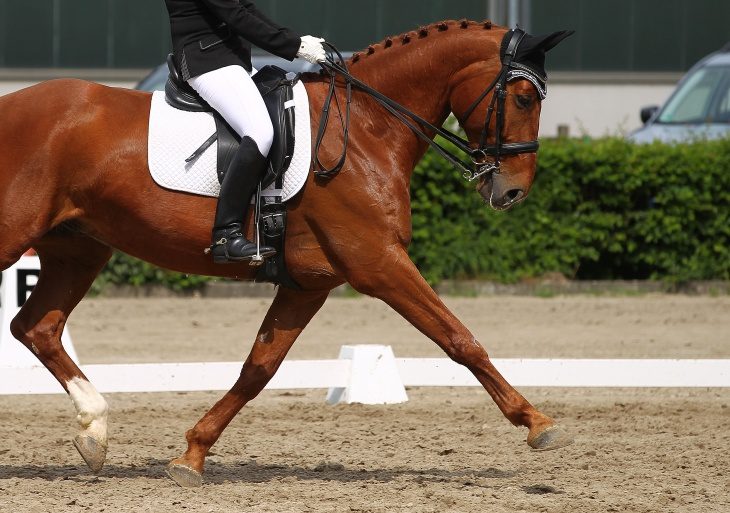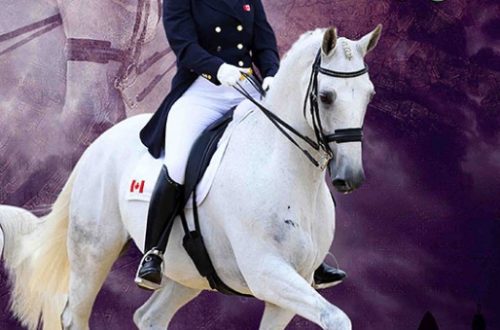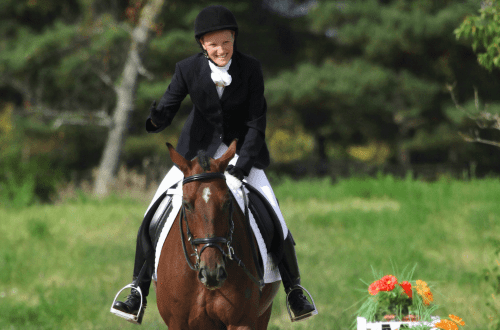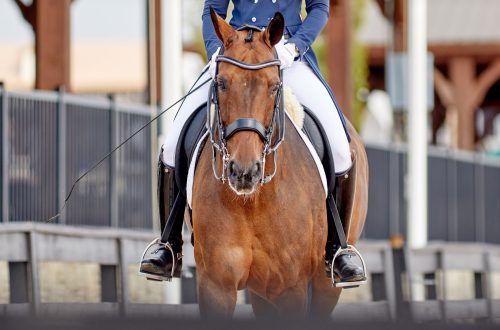
Extending the trot
Extending the trot
You may have experienced that the horse, instead of extending the trot, tends to accelerate or go into a canter. Not every horse is naturally capable of extending the swing while remaining balanced, but every horse can be taught to do so with patience and enriching his training with a number of exercises.
The stride of the trot can be extended, no matter how balanced the horse is. By doing certain exercises, you can improve the movement of the horse and increase his attention.
What do we train the horse first of all? The fact that the leg gives the command “Move”.
Continuing the training, we ask the horse to bend the hind legs at the joints and place them further under the body. This allows her to push off the ground with bоmore momentum and take wider steps without increasing speed, without changing pace. The horse, however, must understand your means of control, be aware of exactly how you are trying to influence his hind legs. Below we describe two exercises that will help the horse acquire this skill.
The first is to tell the horse how the side-shifting leg works. Doing it will improve the horse’s response to your commands, make his shoulders more mobile, and get his hindquarters involved.
The second exercise involves the use of poles. This will encourage the horse to lengthen the trot steps gradually without losing balance.
When starting to work on the exercises, keep in mind that you will need a lot of practice before the horse learns to lengthen the trot without increasing speed. The best way to train her without causing resistance is to do everything gradually, breaking the training plan into small steps. Make sure the horse understands each of the tasks you set before moving on to the next one.
Use these exercises in your work about three times a week. Do not overdo it, do not overload the horse – working to wear and tear will not do any good. The horse must not be overstressed.
Exercise 1.
Step 1.
Front turn.
To train the horse to move his hind legs to the side in response to leg pressure on one side, we will use the front turn exercise: the horse will have to make a circle with his hind legs around his front legs.
Horses learn to perform this element especially quickly if they start working on it from the ground. Here’s how it’s done:
Lead the saddled horse to the center of the arena. Stand at the left shoulder, take the left rein in your left hand, turn the horse’s nose slightly to the left. Then press with your right hand on the side of the horse behind the girth. This will encourage the horse to take a step with the back foot away from you, to the right. As soon as the horse fulfills your request, immediately remove pressure from the side and praise him.
If the horse does not move to the side, try using the handle of the whip instead of the hand. Experiment with where the pressure is applied to find out where the horse responds best. She may be more willing to respond if you push a little further.
Ask the horse to take only one step to the side. Pause after each step to praise the animal. After she takes two or three good steps, go to the other side and ask her to do the same in the other direction.
You will move on to the next step once the horse has mastered the new skill (you may need 2-5 sessions). Now you will need an assistant on the ground.
Sit in the saddle, and your assistant will take place at the horse’s shoulder where you were previously. Take a rein long enough to maintain contact. Pick up the left rein to turn the horse’s nose slightly to the left. Then push with your foot where you pressed with your hand or whip. As soon as the horse takes a step to the side, relax your leg and pet the horse. If she does not take a step to the side, then have your assistant push her with a hand or a whip, reminding her of the previous lessons. Repeat the same in the other direction.
Over time, the horse will begin to understand what the side-shifting leg command means. She should synchronize her steps with your signals, and not spin in place haphazardly. After the horse begins to understand what you want from him, work on your own, without an assistant from the ground. Your goal is to learn how to use side-shifting aids without having to hold the reins back from moving forward.
Let’s explain the above with the help of illustrations:
Lindau, a 13-year-old Holstein gelding is learning to respond to side-shifting leg movements. Standing at the left shoulder, I turn his nose slightly to the left with the left rein. Then I press with my hand behind the girth, where I would work with a leg. Lindau steps in a circle with his hind legs around his front legs..
After Lindau understands what I ask of him, I sit in the saddle and perform the same actions while sitting on horseback. To simplify the task, I ask my assistant to assist me from the ground. Lindau easily completes the task in response to our joint messages. Soon I was able to get him to turn on the front without the support of an assistant.
Exercise 1.
Step 2.
Forward and to the side.
It’s time to add forward movement to our lateral movement.
We will be doing a slight leg yield on a short diagonal from the quarter line to the arena wall. For a horse, the movement to the wall of the arena is very attractive. Moving along a short and not steep diagonal, you will not make her nervous.
Let’s not demand the right concession – let the horse move forward and quite a bit to the side. Do not think about how her body is bent and her legs are crossed. Now it doesn’t matter.
While walking, go to the fourth line. Walk straight for a few steps, then bend the horse to the right (we do not require leg yielding, which should not have a bend in the body!).
Then press on the side of the horse with your right foot as you did in the previous exercise. Press and release your leg in time with the horse’s steps. The horse should continue to move forward and shift slightly to the left. As with the front turn, your right foot will do all the work. The left should lie passively on the side of the horse in order to open the way for it to the side.
If necessary, half-halt with the outside rein (in this case, the left) to balance the horse, even out the pace, and prevent shoulder drop. Use the reins as if you were squeezing water out of a sponge. The half halt must be in sync with the horse’s steps. You must not pinch it. The purpose of this exercise is to keep the horse relaxed and to give clear, understandable commands. If the horse is accelerating, use a half halt to slow it down.
Ask only two or three steps to the side. As before, one leg press is one horse step. Then walk forward in a straight line and again repeat the movement forward and to the side.
Repeat this exercise several times in both directions. Use it at work every day. Each time, ask for more steps forward and to the side.
Remember, your goal is to encourage your horse to take wider strides with his hind legs confidently and calmly in response to your leg. When you start asking your horse for more lateral strides, do it in a smooth diagonal, not at a steep angle to the wall.
Don’t experiment with the placement of your legs to activate the horse’s forehand or hindquarters. Pull your leg further behind the girth to activate your butt. Move the leg forward, closer to the horse’s elbow joint, to make it lead the forehand. Look for a sweet spot where all four legs will move sideways evenly while keeping your torso parallel to the wall of the arena. You will help the horse explore the possibilities of his own body.
When the horse is confident in this exercise at the walk, repeat it at the trot. Make sure your fit is correct. Move at a posting trot so as not to interfere with the horse. This will also allow you to work your leg in sync, pressing it down when you get into the saddle and softening it up when you get up.
Let’s see how it looks.
1. Go to the fourth line. Walk a couple of steps in a straight line. Make sure the horse moves calmly and uninhibited.
2. Bend the horse slightly to the right before asking for sideways movement.
3. Take a few steps forward and to the side. Then straighten your horse again and move in a straight line. Then again a couple of steps forward and to the side. Keep repeating your steps until you reach the arena wall.
Exercise 1.
Step 2.
Forward and sideways at a trot.
1. After the horse has learned to step forward and sideways at the walk, you can begin this exercise at the trot: moving straight on the quarter line, then asking him to trot a few steps forward and sideways. Notice how the horse’s hind legs cross!
2. Take a few strides at the trot in a straight line. Moving forward and sideways activates the horse’s hindquarters and forces him to take wider strides. Work at a posting trot so as not to interfere with the horse.
Exercise 1.
Step 3.
We lengthen the steps.
Once your horse is comfortable with moving forward and sideways at the trot, you can ask him to lengthen his trot.
Start by moving along the quarter line, as you did before. Engage your leg to move the front of the horse slightly towards the arena wall. But this time, when you give the leg command to the beat of the trot, extend the pressure and engage the second leg. This will encourage the horse to lengthen the swing.
Since the forehand will be lighter due to the lateral movement, the front legs will also be able to show a wider stride, thus giving room for the hind legs as well.
At this stage it is very important that you maintain your balance and do not disturb the balance of the horse. Do not lean forward, maintain a steady rhythm of the posting trot, preventing yourself and the horse from accelerating.
Keep in constant contact. Without the necessary connection, the horse will go into a canter. By maintaining light contact, you encourage the horse to create more momentum and thus take wider strides.
Reward your horse for any positive change. As soon as she can perform the task calmly and confidently, you will ask her to extend the trot stroke diagonally without lateral movement. In the end, you will cope with the full diagonal.
And again illustrations:
1. Once the horse is aware of the shearing action of the leg, begin to learn to extend the trot in response to the impact of the two legs. Pay attention to how the horse’s butt is summed up. Coming to the fourth line, we perform a couple of measures of the trot in a straight line.
2. Then, with the inside (right) leg, bend the horse a little to the right to ask for a little movement to the side. Notice how the horse’s hind leg joints are bent, as well as the increased range of motion in the shoulder.
3. Level the horse and apply pressure with two legs. The energy created is enough for the horse to extend the trot.
Exercise 2: Poles
Another way to train your horse to lengthen the trot is with the poles.
Start with one pole. Work on it at a calm and even pace in both directions at a walk, going in the center. Then lift the horse into a trot and work the trot. Keep track of the contact. Maintain a proper seat so as not to disturb the balance of the horse. Don’t overdo it with leg work. Engage the leg only when the horse loses momentum.
Then add two more poles, placing them at the same distance from each other. Adjust the distance to suit your horse’s trot. The horse should be comfortable and comfortable.
Work three poles at the posting trot in both directions. Come to the center. Keep the rhythm of the movement. Close your leg every time you sit in the saddle. This will keep the horse from losing momentum.
When the horse begins to trot calmly and relaxed over the poles, gradually widen the distance between the poles. Now, closing the legs in sync with the rhythm of the horse’s movement, extend the pressure for a fraction of a second. This will allow the horse to link the wider trot with leg pressure.
Never increase the distance abruptly, do not make it too wide. The horse must be comfortable – he must not lose his balance and move too aggressively, otherwise he will lose confidence in himself.
To save time, you can install two sets of poles. One – with the optimal distance, the second – with extended. As the horse becomes more confident, you can widen the spacing between the poles.
As a result, distance will cease to be a significant factor. Much more important is to teach the horse to remain calm and confident. With experience, she will learn to extend the trot only from your leg pushes. Gradually you will be able to remove the poles.
Alternate both exercises to add variety to your workouts and not make them a routine for your horse.
Bruno Greber; translation by Valeria Smirnova (source)





